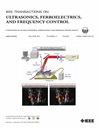适用于 COVID-19 患者的估算聚集红细胞反向散射系数的无幻影方法。
IF 3
2区 工程技术
Q1 ACOUSTICS
IEEE transactions on ultrasonics, ferroelectrics, and frequency control
Pub Date : 2024-11-07
DOI:10.1109/TUFFC.2024.3493602
引用次数: 0
摘要
超声波后向散射系数是生物组织固有的一个频率依赖量,可从后向散射的射频信号中恢复,前提是在相同的系统设置下对参考模型进行采集。基于点扩散函数的高斯近似(扫描仪探头的电子和压电特性)和有效介质理论与结构因子模型相结合,提出了一种无模型反向散射系数估算方法,但该方法也适用于其他模型。同时,介入组织引起的总衰减将根据理论值进行细化,理论值基于报告的组织平均行为,同时允许对探头几何形状引起的衍射进行校正。除高斯近似值外,参考模型法也采用了类似的方法。对 10 名 COVID-19 阳性患者和 12 名对照组进行了股静脉和动脉测量,比较了所提出的无模型方法和参考模型方法。在这种情况下,红细胞被视为散射体,在 COVID-19 炎症条件下形成聚集体,增加了反向散射。所考虑的模型由五个参数组成,包括根据聚集体半径的多分散性及其形状的各向异性估算的平均聚集体大小。两种建议方法的平均聚集体大小的类内相关系数为 0.964,具有一致性。尽管血管内的最大多普勒速度和血管直径会产生混杂效应,但采用这两种方法得出的聚集体大小在两组之间仍存在显著差异。本文章由计算机程序翻译,如有差异,请以英文原文为准。
A Phantom-Free Approach for Estimating the Backscatter Coefficient of Aggregated Red Blood Cells Applied to COVID-19 Patients
The ultrasound backscatter coefficient (BSC) is a frequency-dependent quantity intrinsic to biological tissues that can be recovered from backscattered radio frequency (RF) signals, granted acquisitions on a reference phantom (RP) are available under the same system’s settings. A phantom-free (PF) BSC estimation method is proposed based on Gaussian-shaped approximation of the point spread function (PSF) (electronics and piezoelectric characteristics of the scanner’s probe) and the effective medium theory combined with the structure factor model (EMTSFM), albeit the proposed approach is amenable to other models. Meanwhile, the total attenuation due to intervening tissues is refined from its theoretical value, which is based on reported average behaviors of tissues, while allowing correction for diffraction due to the probe’s geometry. The RP method adapted to a similar approach except for the Gaussian approximation is also presented. The proposed PF and RP methods were compared on ten COVID-19 positive patients and 12 control subjects with measures on femoral veins and arteries. In this context, red blood cells (RBCs) are viewed as scatterers that form aggregates increasing the backscatter under the COVID-19 inflammatory condition. The considered model comprises five parameters, including the mean aggregate size estimated according to the polydispersity of aggregates’ radii, and anisotropy of their shape. The mean aggregate size over the two proposed methods presented an intraclass correlation coefficient (ICC) of 0.964 for consistency. The aggregate size presented a significant difference between the two groups with either two methods, despite the confounding effect of the maximum Doppler velocity within the blood vessel and its diameter.
求助全文
通过发布文献求助,成功后即可免费获取论文全文。
去求助
来源期刊
CiteScore
7.70
自引率
16.70%
发文量
583
审稿时长
4.5 months
期刊介绍:
IEEE Transactions on Ultrasonics, Ferroelectrics and Frequency Control includes the theory, technology, materials, and applications relating to: (1) the generation, transmission, and detection of ultrasonic waves and related phenomena; (2) medical ultrasound, including hyperthermia, bioeffects, tissue characterization and imaging; (3) ferroelectric, piezoelectric, and piezomagnetic materials, including crystals, polycrystalline solids, films, polymers, and composites; (4) frequency control, timing and time distribution, including crystal oscillators and other means of classical frequency control, and atomic, molecular and laser frequency control standards. Areas of interest range from fundamental studies to the design and/or applications of devices and systems.

 求助内容:
求助内容: 应助结果提醒方式:
应助结果提醒方式:


